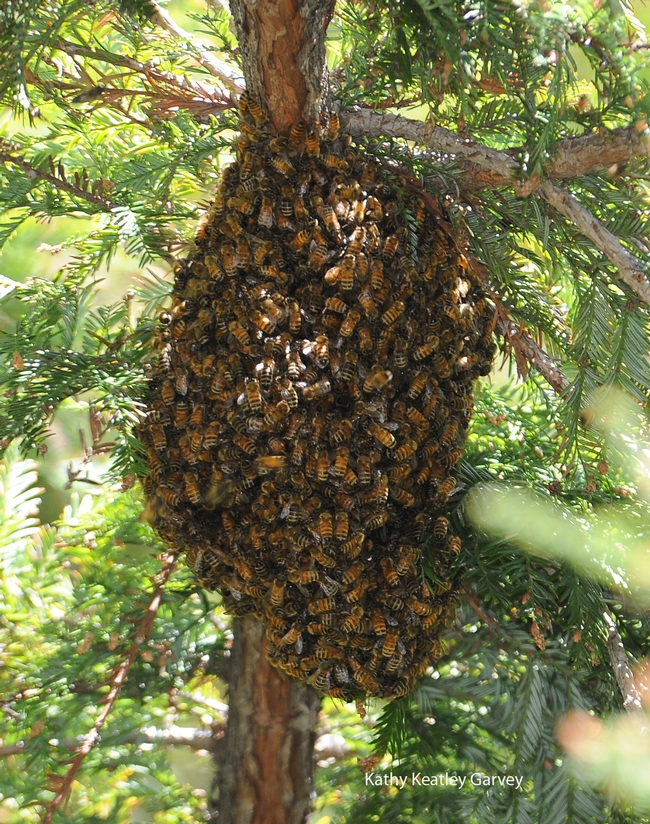Bee swarms are absolutely fascinating.
Several years ago, when bee breeder-geneticist Susan Cobey was teaching a queen- rearing class at the Harry H. Laidlaw Jr. Honey Bee Research Facility at UC Davis, her students received an extra bonus: they witnessed a bee swarm.
Right in front of them, as if on cue, the bees left the entrance of a hive and clustered on a nearby tree branch. That was Lesson No. 1. Cobey and crew quickly captured them and moved the swarm to a vacant hive. That was Lesson No. 2.
Actually, bee swarms aren't that rare on the UC Davis campus. They're just difficult to see because we're usually looking down instead of up.
This week UC Davis employee Suzan Carson alerted us to a bee swarm in the North Hall/Dutton Hall complex. She pointed to a tree branch, about 30 feet off the ground, where, in the deepening shadows, a cluster hung like grapes. "Good eye!" we said.
Today, toting my telephoto lens, I returned to capture an image of the cluster. They were still there, but probably won't be for long. The pending rainstorm may drive them from their temporary home, observed Extension apiculturist Eric Mussen of the UC Davis Department of Entomology.
Norman Gary, emeritus professor of entomology at UC Davis, explains the ins and outs of swarms in his newly published book, Honey Bee Hobbyist: The Care and Keeping of Bees.
"The act of swarming is perhaps the most dramatic event in the lives of honey bees," Gary writes. "Here's how it happens: Egg production increases dramatically in response to warming spring weather as well as an abundance of pollen and nectar from spring flowers. Within a few weeks, the colony population essentially doubles. Multiple queen cells--usually at least six--are constructed in the brood nest. A few days prior to the emergence of a virgin queen, the old queen's ovaries begin to shrink. Egg-laying essentially stops, and she loses enough weight to permit flight for the first time since her mating flight."
So basically there's "no room in the inn" for the burgeoning population. The colony divides. The swarm usually heads for a nearby tree to cluster on a branch while the scouts search for a new--and appropriate--home.
Meanwhile, back at the old hive, new queens are emerging and what happens next isn't pretty. "Rival queens engage in fierce stinging attacks until only one virgin queen remains," Gary writes.
About a week later, the victorious queen will depart on her mating flight to a drone congregation area, mate with 12 to 25 or so drones, and then return to the hive to lay eggs--as many as 2000 a day during the peak season.
The queen will never leave the hive again...
Unless, on a warm spring day...
Attached Images:

Honey bee swarm in the North Hall/Dutton Hall complex at UC Davis. (Photo by Kathy Keatley Garvey)